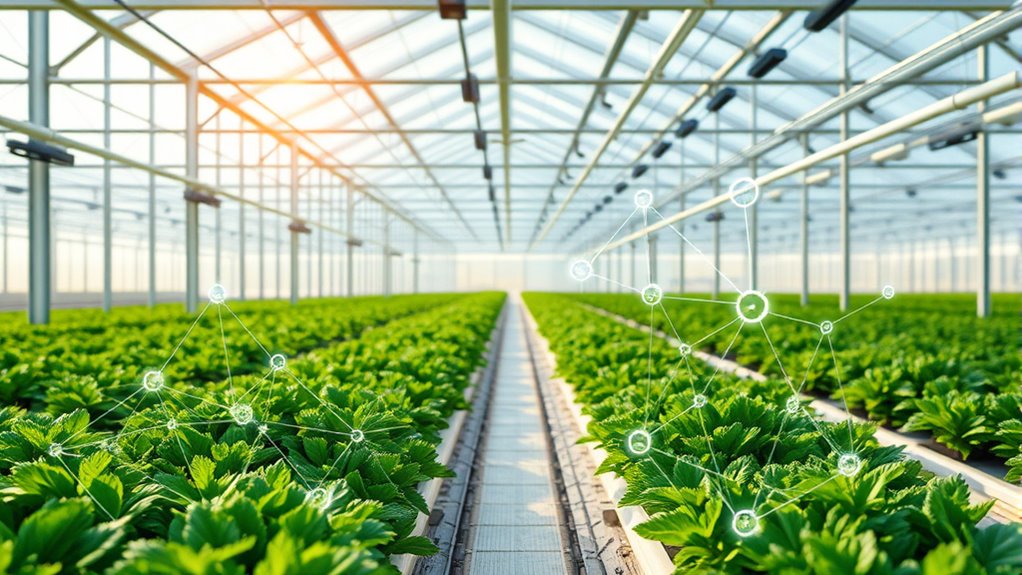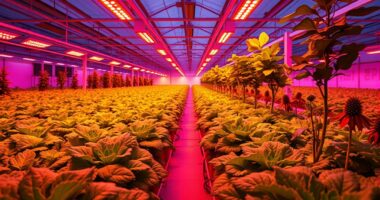Blockchain technology in greenhouse supply chains offers you a secure and transparent way to track produce from farm to table. It creates an unchangeable record of each step, helping you verify origin, handling, and transport conditions effortlessly. This boosts trust with consumers, reduces fraud, and improves efficiency across stakeholders. By using blockchain, greenhouse operations position themselves as leaders in sustainability and accountability. Keep exploring to discover how this innovative approach can revolutionize your supply chain management.
Key Takeaways
- Blockchain creates a secure, tamper-proof ledger that enhances traceability of greenhouse produce from origin to consumer.
- It enables real-time tracking of product handling, transportation, and storage conditions, improving supply chain transparency.
- Blockchain reduces fraud and falsified records by securely verifying each transaction and process within the supply chain.
- It streamlines compliance with safety standards and regulatory requirements through secure, accessible documentation.
- The technology fosters collaboration among growers, retailers, and stakeholders, boosting efficiency and consumer trust.

Have you ever wondered how blockchain technology can transform greenhouse supply chains? It’s a game-changer, especially when it comes to traceability systems and supply chain transparency. With traditional methods, tracking produce from greenhouse to consumer often involves paperwork, multiple intermediaries, and a lack of real-time data. This can lead to errors, fraud, or delays that compromise product quality and safety. Blockchain addresses these issues head-on by creating a secure, decentralized ledger that records every transaction and movement of goods in an unchangeable way. When you implement blockchain for traceability systems, you gain a clear, tamper-proof record of each step in the supply chain. This means you can verify the origin of produce, monitor conditions during transport, and ensure proper handling—all in real time. As a result, supply chain transparency becomes more than just a buzzword; it becomes an operational reality. You can provide consumers with detailed information about how their food was grown, harvested, and transported, fostering trust and confidence in your products. Blockchain’s transparency also helps identify bottlenecks or inefficiencies quickly, allowing you to address issues promptly and reduce waste. For greenhouse operators, this means better management of resources, improved quality control, and the ability to demonstrate sustainability practices to buyers and regulators. Because each transaction is secured with cryptography, you eliminate the risk of fraud or falsified records, which is essential in maintaining integrity throughout the supply chain. Additionally, blockchain’s decentralized nature means no single party controls the data, reducing the chances of manipulation and increasing accountability. This assures partners, retailers, and consumers that the information they rely on is accurate and trustworthy. The technology also streamlines compliance with safety standards and regulatory requirements, as all necessary documentation can be stored securely and retrieved instantly. In essence, adopting blockchain enhances your ability to offer a transparent, reliable, and efficient supply chain. It fosters collaboration among stakeholders, from growers to retailers, by providing a shared platform where everyone can access verified data. This not only improves operational efficiency but also boosts your reputation in a competitive market. As consumer demand for ethically and sustainably produced goods grows, blockchain’s role in strengthening traceability systems and supply chain transparency becomes even more critical. By leveraging this innovative technology, you position your greenhouse operation at the forefront of transparency and accountability, ensuring your products stand out for their quality and trustworthiness. Additionally, blockchain’s ability to create a secure, decentralized ledger helps reduce the risk of data manipulation and enhances overall supply chain integrity.
Frequently Asked Questions
How Does Blockchain Ensure Data Privacy in Greenhouse Supply Chains?
You can trust blockchain to protect your data privacy through data encryption and strict access controls. It encrypts sensitive information, making it unreadable to unauthorized users, while access controls ensure only authorized parties can view or modify data. This combination keeps your greenhouse supply chain data secure, prevents breaches, and maintains transparency without sacrificing privacy, giving you peace of mind throughout the entire process.
What Are the Initial Costs of Implementing Blockchain Technology?
Jumping into blockchain is like planting a seed—initial costs can seem high. You’ll face investment challenges like hardware, software, and training expenses, which require thorough cost analysis. The upfront investment varies based on your greenhouse size and system complexity, but be prepared for ongoing maintenance too. While costly at first, these investments lay a sturdy foundation for transparency and efficiency, ultimately saving you money in the long run.
How Does Blockchain Handle Supply Chain Disruptions?
Blockchain helps you handle supply chain disruptions by providing real-time inventory tracking and transparent supplier verification. When disruptions occur, you can quickly identify where the problem lies, verify supplier credentials instantly, and trace inventory movements accurately. This transparency allows you to respond faster, coordinate with suppliers more efficiently, and minimize delays, ensuring your greenhouse supply chain remains resilient despite unforeseen challenges.
Can Small-Scale Greenhouses Adopt Blockchain Solutions Effectively?
Yes, small-scale greenhouses can adopt blockchain solutions effectively. While scalability challenges exist, you can start with basic implementations that suit your size and needs. Technology accessibility has improved, making it easier for you to integrate blockchain without significant costs or expertise. By focusing on simple, targeted uses like tracking produce or verifying suppliers, you can benefit from blockchain’s transparency and security without overwhelming your operations.
What Are the Long-Term Environmental Impacts of Blockchain Use?
You’ll find that blockchain technology can reduce your greenhouse’s carbon footprint by increasing transparency and efficiency. It promotes resource conservation by streamlining supply chains, minimizing waste, and optimizing energy use. Over the long term, this means less environmental impact, helping you contribute to global sustainability efforts. However, it’s essential to contemplate energy consumption from blockchain operations itself, and aim for energy-efficient solutions to maximize these positive environmental benefits.
Conclusion
By embracing blockchain technology, you can transform your greenhouse supply chain into a tightly woven tapestry of transparency and trust. It acts like a lighthouse guiding your operations through the fog of complexity, ensuring every link is secure and accountable. As you harness this innovative tool, you’ll not only boost efficiency but also cultivate confidence among partners and consumers alike. Ultimately, blockchain becomes the heartbeat that keeps your supply chain resilient, transparent, and ready for the future.









